Herbivory of sympatric elk and cattle on Lincoln National Forest, south-central New Mexico
Wildlife and livestock grazing are important products of forest ecosystems, but can be controversial. Herbivory by North American elk and domestic cattle is a contentious management issue throughout western No...
